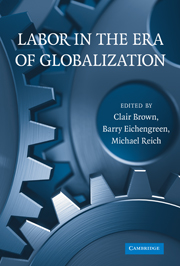Book contents
- Frontmatter
- Contents
- Tables and Figures
- List of Authors and Editors
- Introduction: Labor in the Era of Globalization
- PART ONE POLITICAL ECONOMY AND LABOR MARKET INSTITUTIONS
- PART TWO INSTITUTIONS AND FIRM AND WORKER BEHAVIOR
- 4 How Good Are U.S. Jobs? Characteristics of Job Ladders across Firms in Five Industries
- 5 Increasing Labor Flexibility during the Recession in Japan: The Role of Female Workers in Manufacturing
- 6 Ties That Matter: Cultural Norms and Family Formation in Western Europe
- PART THREE CONTEMPORARY LABOR–MANAGEMENT RELATIONS
- PART FOUR PUBLIC POLICY AND U.S. LABOR-MARKET STRUCTURE
- Index
- References
4 - How Good Are U.S. Jobs? Characteristics of Job Ladders across Firms in Five Industries
Published online by Cambridge University Press: 05 June 2012
- Frontmatter
- Contents
- Tables and Figures
- List of Authors and Editors
- Introduction: Labor in the Era of Globalization
- PART ONE POLITICAL ECONOMY AND LABOR MARKET INSTITUTIONS
- PART TWO INSTITUTIONS AND FIRM AND WORKER BEHAVIOR
- 4 How Good Are U.S. Jobs? Characteristics of Job Ladders across Firms in Five Industries
- 5 Increasing Labor Flexibility during the Recession in Japan: The Role of Female Workers in Manufacturing
- 6 Ties That Matter: Cultural Norms and Family Formation in Western Europe
- PART THREE CONTEMPORARY LABOR–MANAGEMENT RELATIONS
- PART FOUR PUBLIC POLICY AND U.S. LABOR-MARKET STRUCTURE
- Index
- References
Summary
INTRODUCTION
This chapter documents and examines firms' job ladders (i.e., initial earnings, earnings growth, and tenure) in the ten-year period 1992–2001 through analysis of a national linked employer–employee dataset, informed by fieldwork in five industries (financial services, retail foods, semiconductors, software, and trucking). Specifically, we examine the insufficiently studied question: What do earnings progressions for individuals look like within firms and how do earnings progressions vary across different types of firms in the same industry? Our addition to the literature is to identify the job ladders that prospective workers face within an industry. We find that job ladders vary greatly both across and within the five industries and that patterns of job ladders by firm characteristics within and across industries reflect the institutional dynamics of the industries.
In our fieldwork in the five industries, we observed several types of human resource management (HRM) systems in firms and industries across time. Some companies provide their workers with long job ladders with high initial earnings and earnings growth that reflect the skill development of the workers, and workers tend to stay. This type of HRM is called an internal labor market (ILM) and historically was common in large, growing companies that had market power. However, competitive pressures in the past two decades have led companies to restructure their ILMs (and HRM generally) to be more market-driven and performance-based (Cappelli 1999; Osterman 1996).
- Type
- Chapter
- Information
- Labor in the Era of Globalization , pp. 153 - 190Publisher: Cambridge University PressPrint publication year: 2009
References
- 1
- Cited by



